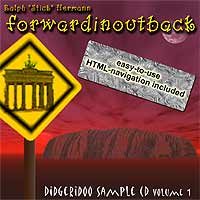
We've often wondered why the didgeridoo, one of the world's oldest and most exotic sounding wind instruments, isn't heard more often. Maybe its distinctive drone - rough, wild, primitive, but rich in overtones - is so closely associated with aborigines and the arid Australian outback that most musicians shy away from using it in any other setting. Or maybe too few know how to play it. It requires combined techniques of lip vibration, vocalization and circular breathing in order to drive its sustained hypnotic sound.
But the didgeridoo can be versatile. Its tone, for example, varies by the material from which it's crafted. Although traditionally made from eucalyptus branches hollowed out by termites, it's now often made from other woods, bamboo, or even metal. The way it's played can also vary. Although the aborigines traditionally used vocalization techniques to mimic animal and other natural sounds, such as owls and kookaburras, a player can create many other sounds by means of the mouth or voice. And by using circular breathing in combination with vocalization, a musician can also produce a steady, seamless rhythm over the instrument's other-worldly drone. If that's not enough, by adding a few digital effects, a player can exponentially increase the options for inventing an original sound. When I heard that all of these features were packed into a new and unique CD-ROM recorded by Berlin musician and composer Ralph "Stick" Hermann, I was eager to hear it. I wasn't disappointed.
forwardinoutback Didgeridoo-Samples Volume 1 contains more than 350 high-quality samples played on seven didgeridoos handmade from birch, spruce, bamboo and steel, and recorded professionally in 44.1 kHz, 16-bit, mono/stereo, WAV file format, using Wavelab and Cubase Audio software.
The samples are categorized by the type of didgeridoo played, as well as the length or type of sample, and - in the case of loops - the rhythmic phrasing. The length or type of sample refers to short or long sounds, meditation-length sessions, and loops recorded both dry and with layered effects. Although the samples are not evenly distributed throughout the different categories (some contain dozens of samples, while others contain only one or two), there is no lack of variety.
Not surprisingly, of the seven kinds of didgeridoos played on the disc, the steel one is the most distinctive sounding. Although it produces a thinner, colder, sharper, somewhat more hollow and less guttural tone than the others, it is not at all unpleasant or sterile. In fact, it suggests a modernized, slightly tamed instrument with a metallic "buzz" that might be especially appropriate to electronic music, or to a techno, futuristic setting. The wood and bamboo instruments, on the other hand, offer the thicker, multi-resonant tones and the typical roughness expected of the more traditional didgeridoo.
The loop sets are sampled phrases of various didgeridoos played in lengths of 1 to 8 bars and in multiple BPMs, keys and rhythm patterns. They are particularly useful for creating unique sounding rhythm tracks. A few of these sets, for example, called shuffle loops, are based on rhythms suitable for blues or funk. But several other sets contain loops that offer the strangest, most intriguing sounds of all. They have been layered with digital effects - such as reverb, grungelizer, flanger, etc. - that sometimes seem to transform the didgeridoo into an entirely different kind of instrument.
Unlike the loop sets, the sets of short sounds (up to 10 seconds), long sounds (up to 30 seconds) and meditation-length sessions (up to 6 minutes) are free-form and not formatted in consistent rhythms or bar measurements. Although these sounds can be looped, too, if desired - and some include effects - the results are different from the rhythmically phrased loops. The longer samples, in particular, seem most useful for background sounds and ambience. But their free-form structure offers important additional opportunities. They can be split up and edited to create an almost infinite variety of other samples. Add your own effects, and the possibilities are unlimited.
For easy navigation through the sample directories and to provide technical information about the samples, the CD contains a built-in, 39-page guide written in HTML format to be read by your Internet browser. In my case, the program that calls the guide couldn't find my browser's WAV file reader and suggested that I need to download one. But, after that initial glitch, there were no further problems. The browser read the HTML pages normally, and as soon as I clicked on a WAV file to preview it, the WAV reader came up as usual. But the guide, although a convenient navigation aid and important to read at least once, is not needed afterwards if you prefer not to use it. The disc's directories and samples can be accessed directly by your software, and, of course, the samples can be copied to your hard drive.
In all cases, I found the editing and sound to be very high quality. And because of their odd, sometimes weird, nature, the samples are both interesting and fun to play with, suggesting new ideas at every turn. Thanks to this disc, the didgeridoo is not limited to outback settings anymore. These samples could be easily adapted for many kinds of music production: commercials, dance, theater, sci-fi, fantasy, horror, effects, ambience, chant, rhythm, or even comedy. Imagination is the key.
Available from forwardinoutback, where you can also download some of the samples in MP3 format, or buy a handmade didgeridoo.
CD Price: $49.00 U.S. (See other currency prices at the site.)
Reviewed in May 2001.
Product review posted by Musician's Tech Central
Copyright © 1997-2025
James A. Putnam
All Rights Reserved
|